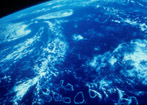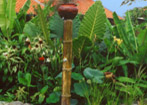|
Great Barrier Reef, Australia
2nd May - 10th June 2006
We arrived into Cairns, Australia and docked for a few days at
the Marlin Marina while we got our bearings in what seemed like
quite a big city after so long in the islands of the Pacific.
We moved further up the Trinity River to anchor close to mangroves
and the shipyards. Heraclitus was in Cairns more than twenty years
ago and it was amazing how many people remembered the ship, including
the Harbour Master who still monitors the traffic in and out of
the port.
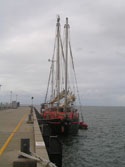
Heraclitus on the dock just after arrival
into Cairns
May is the transition between the wet season and the dry season
and we sat through long bouts of wind, gusting up to 35 knots.
It’s a month of turbulent weather but despite the rough
conditions, tour boats headed out to the Great Barrier Reef every
day. There was an extraordinary gathering of bats over the city
one evening at dusk. Most passersby were oblivious but we found
ourselves transfixed by the spectacle
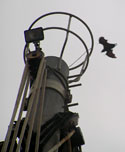
bats fly over the crow's nest in Cairns
We took a brief trip to Low Isles for a weekend to get our feet
wet on the largest coral reef system in the world. The wind was
still blowing strong and on our dives we could see no more than
a metre so found it hard to gauge the state of the reef. But there
were plenty of turtle sightings. We sat beneath the beam of the
lighthouse for a few nights and then motored our way back against
the trades into Cairns.

Low Isles
This time, many of us took some time off the ship to explore
a little further into Australia’s interior – the Atherton
Tablelands, the outback and even as far as the Gulf of Carpentaria.

the Granite Gorge
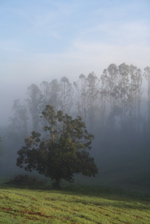
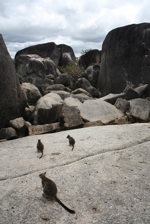
the Atherton Tablelands, wallabies
On 31st May we departed Cairns for Low Isles, this time to conduct
our study on its reef. Professor Ove Hoegh-Guldberg at the University
of Queensland had suggested this as one of our study sites on
the Great Barrier Reef and we were very attracted to it because
of the work carried out here by an expedition in 1929, led by
Sir Maurice Yonge of the Royal Society in London. We read some
of their expedition log, including descriptions of the researchers’
diving helmet, linked by an airline to a tender with a hard-working
pumper providing the air.
Steve and Louise Sharpe are the volunteer caretakers of the island
who live there with their young son Thomas. The lighthouse itself
is now completely automated and runs from solar panels. A 35 Watt
lightbulb provides a beam (through lenses) that was strong enough
to light up our mainsail while we were still two miles off the
island. At times it felt like we were in a turtle sanctuary. We
encountered them every time we were in the water and would frequently
see them surfacing from either the small boat or the ship.

The views from our anchorage of the mainland of Australia were
stunning – the Great Dividing Range bathed in colour from
sunrise to sunset. Lights from shrimping boats scattered the horizon
at night, while they anchored close to us during the day. Several
boats from Port Douglas bring daily loads of tourists to snorkel
and lounge on the white sand beach, including an original Chinese
junk from Hong Kong called Shaolin.
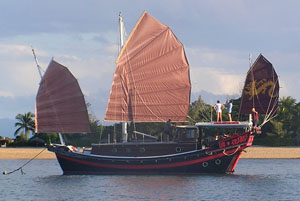
the Shaolin which visited Low Isles almost
daily
|



